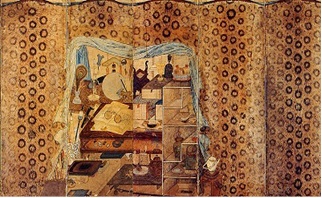|

Myths My Teachers Believed about Song-Yuan Painting History
Friday, November 03, 2017
1:00 PM - 3:00 PM
Bunche Hall 6275
Sammy Lee Seminar by Jerome Silbergeld, Princeton University
MYTHS MY TEACHERS BELIEVED ABOUT SONG-YUAN PAINTING HISTORY
and what this means for Chinese art historical practice today
Chinese painting history is a thriving, growing, changing, and diverse discipline. Song and Yuan painting lay at the core of my teachers' academic interests, Song naturalism and the rise of Yuan literati painting. Everything grew out of this. To some in my generation, many of our teachers' "fundamentals" now seem like old-fashioned myths, readily dispelled. To others, these remain central to their own beliefs and to their classroom and museum teaching. How will today's students respond to these issues, or will they still be engaged? Will students even learn of "the way things used to be" in the discipline and the way in which these issues helped shape our entire field today?
Jerome Silbergeld is the P. Y. and Kinmay W. Tang Professor of Chinese Art History at Princeton University, emeritus, and was the director of Princeton’s Tang Center for East Asian Art. He has published more than eighty authored and edited books, exhibition catalogues, articles, book chapters, and encyclopedia entries, as well as curating seven museum exhibitions, on the subjects of traditional and contemporary Chinese painting, architecture and gardens, and Chinese cinema and photographs. These have dealt with such topics as art in times of political upheaval and conditions of intense censorship, the aesthetics of old age, perceptions and misperceptions of historical change, "bad" art and the articulation of the negative, the relationship between architecture and paintings of architecture, regional diversity in Chinese gardens, zoomorphic and anthropomorphic iconographies, and cinema's relationship to the premodern arts of China. Before coming to Princeton in 2001, he was previously the chair of Art History and director of the School of Art at the University of Washington/Seattle, where he taught for 25 years. | |
|

Travels with Chaekgeori:An Art Historical Journey with Korean Screen Painting
Saturday, November 04, 2017
2:00 PM - 3:30 PM
Lenart Auditorium - UCLA Fowler Museum
RSVP HERE
30th Annual Sammy Yukuan Lee Lecture
Cultures appropriate from near and far, for reasons all their own, and they often adapt their borrowings to local standards without knowing the issues that gave rise to these borrowings in the first place. Derived from Chinese models, the Korean genre of chaekgeori – multi-panel screen paintings and scrolls depicting books, antiques, and other collectables – represents their scholars' love of Chinese arts and literature and was initially promoted for political and nationalist purposes. But a still-longer historical sequence underlay chaekgeori, leading back through Qing court culture and Jesuits in China to 15th-century depictions of European scholars' studios. Following separate lines of development in Europe and China, the European scholar's studio gave rise to public museums in the West, while their derivatives failed to do so in China and Korea until a much later date. Why this difference? Such developments exemplify how style and its meanings can become detached and transmitted separately, embedded yet hidden in a global history of meanings and purposes unseen by most who produced and patronized the arts.
Jerome Silbergeld is the P. Y. and Kinmay W. Tang Professor of Chinese Art History at Princeton University, emeritus, and was the director of Princeton’s Tang Center for East Asian Art. He has published more than eighty authored and edited books, exhibition catalogues, articles, book chapters, and encyclopedia entries, as well as curating seven museum exhibitions, on the subjects of traditional and contemporary Chinese painting, architecture and gardens, and Chinese cinema and photographs. These have dealt with such topics as art in times of political upheaval and conditions of intense censorship, the aesthetics of old age, perceptions and misperceptions of historical change, "bad" art and the articulation of the negative, the relationship between architecture and paintings of architecture, regional diversity in Chinese gardens, zoomorphic and anthropomorphic iconographies, and cinema's relationship to the premodern arts of China. Before coming to Princeton in 2001, he was previously the chair of Art History and director of the School of Art at the University of Washington/Seattle, where he taught for 25 years.
About Sammy Lee Lecture Series
First presented in 1982 in celebration of his 80th birthday, the Sammy Yukuan Lee Lectures on Chinese Art and Archaeology honors the life and philanthropy of respected businessman, art collector, and Chinese art authority, Sammy Yukuan Lee. This series is presented annually by the UCLA Center for Chinese Studies with support from the Sammy Yukuan Lee Foundation, and in partnership with the Fowler Museum at UCLA.
| |

















